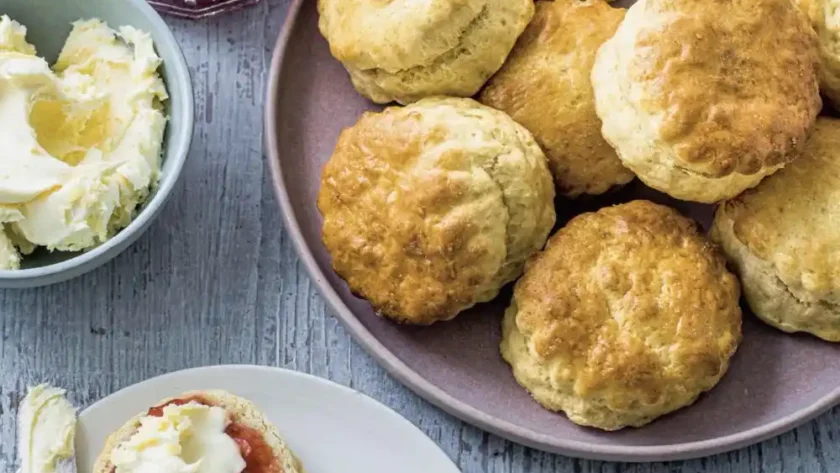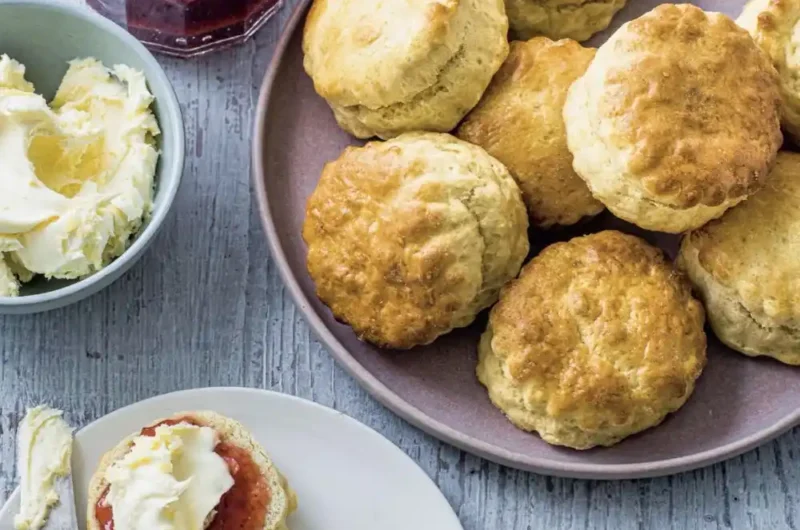I’ve baked a fair few scones in my day, but I’ll be honest—these nearly defeated me the first time. I thought I knew what “just combined” dough looked like. Turns out, I was working it like bread dough and wondering why I ended up with hockey pucks. My nan would’ve been mortified.
It wasn’t until I left the dough ridiculously sticky—like “is this even right?” sticky—that I finally cracked it. These Mary Berry scones came out so fluffy, they practically sighed when I split them open.
If you’ve ever had a flat, dry scone moment (we’ve all been there), let me show you how I fixed that.
Why This One Works So Well
It’s all in the light touch. Most scone recipes will have you roll and re-roll like you’re making puff pastry. But the real magic happens when you barely touch the dough. It should cling a bit to your fingers. Sounds wrong, works like a charm.
Also, Mary’s trick of reserving a bit of the egg-milk mix for glazing? Game-changer. You get that golden top without overbaking the centre. I missed that step once—big mistake. Pale and sad.
INGREDIENTS + WHY THEY MATTER
- All-Purpose Flour (450g) – The base, but don’t pack it in. I spoon and level to avoid dense scones.
- Baking Powder (2½ tbsp) – Yes, that’s a lot. But it gives the lift you want. I once skimped—never again.
- Salt (1 tsp) – Balances the sweetness. Especially key if you’re slathering with jam.
- Salted Butter (75g) – I use it soft, not melted. Rubbing it in gives those crumbly layers.
- Sugar (55g) – Just enough to offset the salt and bring a hint of sweetness.
- Eggs (2 extra-large) – Richness and structure. Medium eggs don’t cut it here.
- Milk (about 225ml) – Brings everything together. Whole milk makes a difference—trust me.
Making It Yours (Without Ruining It)
- Egg-Free: I tested it with 3 tbsp plain yogurt + 1 tsp baking powder per egg. Not quite as fluffy, but still decent.
- Dairy-Free: I tried oat milk and vegan butter—tasted lovely, just less rise.
- Add-ins: Sultanas work great. I soak them in hot tea for 10 minutes, then pat dry.
- Whole Wheat Version: I subbed in wholemeal flour once. Needed a splash more milk, but the nutty flavour was ace.
MISTAKES I’VE MADE (AND HOW TO AVOID THEM)
| What Went Wrong | Why It Happens | How to Fix It |
|---|---|---|
| Rock-hard texture | Over-kneading the dough | Mix just until it comes together |
| Flat scones | Twisted the cutter (guilty) | Press straight down and lift cleanly |
| Dry and crumbly | Not enough liquid or too much flour | Keep dough slightly sticky—trust the process |
| Pale tops | Forgot to glaze or used just milk | Use egg-milk mix for a proper golden finish |
HOW TO MAKE MARY BERRY’S VERY BEST SCONES
- Preheat your oven to 425°F (220°C). Grease two baking trays or line with parchment.
- Mix dry ingredients: In a big bowl, combine flour, baking powder, salt. Rub in the butter with your fingertips until it looks like fine breadcrumbs. Stir in sugar.
- Make the liquid: Beat eggs in a measuring jug, then top up with milk to 300ml. Set aside 2 tablespoons for brushing.
- Bring the dough together: Pour the liquid into the dry mix. Stir with a knife or spatula until just combined. It should look soft and messy—perfect.
- Shape: Tip onto a floured surface. Pat (don’t roll) to ½–¾ inch thick. Use a floured 2-inch cutter—straight down, no twisting.
- Bake: Place on trays, brush tops with the egg-milk mix. Bake for 10–15 minutes until risen and golden. Mine took exactly 13 minutes in a fan oven.
- Cool slightly under a clean tea towel to keep them soft.

TIPS FROM MY KITCHEN
- I warm the milk slightly before mixing—helps it blend faster with the eggs.
- My old metal tray browns the bottoms too fast, so I double up trays if needed.
- I pat dough with my hands only—no rolling pin. It’s gentler.
- I cut the dough thick. Shorter scones rise higher in the oven—go figure.
STORAGE + SERVING
- Room Temp: Best on day one. Still good the next day if wrapped in a tea towel.
- To Reheat: 350°F (180°C) for 5 minutes does the trick.
- Freezer: Freeze baked scones. Warm from frozen in a hot oven for 10 minutes.
- Serve with: Clotted cream and strawberry jam if you’re classic. Lemon curd if you’re bold.
FREQUENTLY ASKED QUESTIONS
Q: Can I freeze the raw dough instead of baked scones?
A: I’ve tried it. Cut the scones, freeze on a tray, then bake from frozen—add 2 to 3 minutes to bake time.
Q: Why are my scones spreading instead of rising?
A: Your dough might be too warm or too wet. Try chilling it for 10 minutes before baking.
Q: Can I use self-raising flour?
A: You can, but skip the extra baking powder—or they’ll balloon and taste bitter.
Q: Do I have to use a fluted cutter?
A: Nope. I’ve used a glass before. Just avoid twisting or they won’t rise straight.
Try More Recipes:
- Mary Berry Wholemeal Scones
- Mary Berry Cheese Scones
- Mary Berry Drop Scones
- Mary Berry Crepes Recipe
Mary Berry Very Best Scones
Course: AppetizersCuisine: UK20
Scones15
minutes15
minutes190
kcalThese nearly flopped my first try—too dry. Turns out, sticky dough is the secret. Here’s how I fixed it.
Ingredients
3⅔ cups (450g) all-purpose flour, plus extra for dusting
2½ tablespoons baking powder
1 teaspoon salt
⅓ cup (75g) salted butter, softened
¼ cup (55g) sugar
2 extra-large eggs
About 1 cup (225ml) milk
Directions
- Preheat oven to 425°F (220°C). Grease or line baking trays.
- Beat eggs, top with milk to 300ml. Set aside 2 tbsp for glaze.
- Mix liquid into dry to form soft, slightly sticky dough.
- Turn onto floured surface, pat to ½–¾ inch. Cut out scones.
- Place on tray, brush tops with glaze. Bake 10–15 minutes.
- Cool on wire rack, covered with clean tea towel.
Notes
- I warm the milk slightly before mixing—helps it blend faster with the eggs.
- My old metal tray browns the bottoms too fast, so I double up trays if needed.
- I pat dough with my hands only—no rolling pin. It’s gentler.
- I cut the dough thick. Shorter scones rise higher in the oven—go figure.

